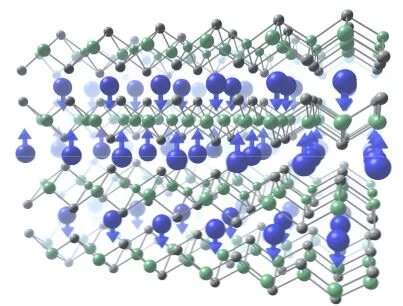In an international collaboration led by scientists from the Fritz Haber Institute in Berlin, a novel approach to controlling the speed of magnetic processes has been developed.
A fundamental limitation on the speed at which magnetic materials can be manipulated, for example for data storage, is given by the dissipation of angular momentum associated with the ordered electron spins. While in ferromagnets all spins are pointing in the same direction, and the angular momentum has to be transferred, e.g., to lattice vibrations, antiferromagnets with two compensating magnetic sublattices (see fig.) enable a direct transfer of angular momentum between opposing spins, thus allowing faster magnetic processes in principle.
The process of angular momentum transfer is closely related to the type of magnetic coupling in the system. In lanthanides (part of the family of the rare earths), magnetic 4f exchange is mediated indirectly via the conduction electrons (RKKY interaction, after Malvin Avram Ruderman, Charles Kittel, Tadao Kasuya and Kei Yosida). The RKKY interaction describes the indirect exchange between the localized magnetic moments of the atoms of a metal. If an electron comes close to a magnetic atom, it aligns its spin with it. If the electron now moves further through the solid, the spin polarization of the electron can in turn influence an alignment of the magnetic moment of one of the neighboring atoms. So far, the effects of such conditions on antiferromagnetic direct spin transfer are largely unexplored.
In their study, the researchers used time-resolved resonant X-ray diffraction to investigate the ultrafast dynamics of magnetic order in a series of 4f antiferromagnets on a femtosecond (10-15 s) time scale. Thereby, they additionally systematically varied the occupation of the 4f orbitals—and thus the strength of the RKKY coupling. In conjunction with ab-initio calculations of the magnetic interaction parameters, they were able to demonstrate that the angular momentum transfer rate between opposing moments is directly determined by the strength of the RKKY interaction. Given the direct relationship between RKKY and the conduction electrons, the results offer a novel approach to controlling the rate of magnetic processes.
More information:
Y. W. Windsor et al, Exchange scaling of ultrafast angular momentum transfer in 4f antiferromagnets, Nature Materials (2022). DOI: 10.1038/s41563-022-01206-4
Provided by
Max Planck Society
Citation:
Controlling the speed of magnetic devices (2022, February 25)


